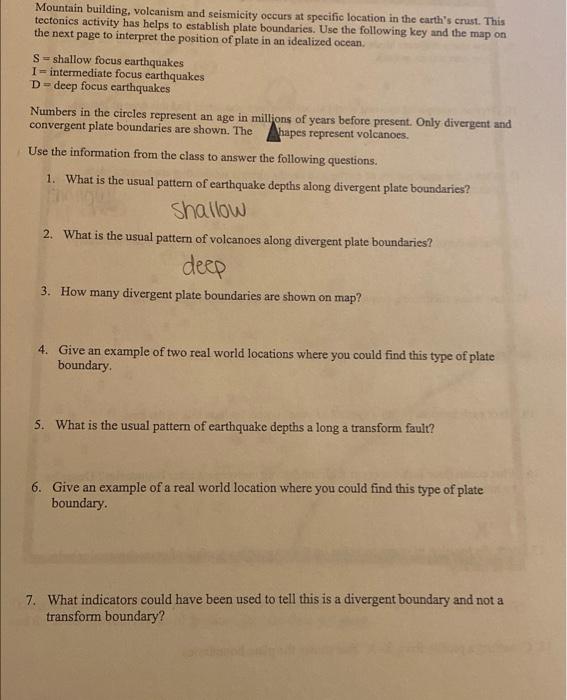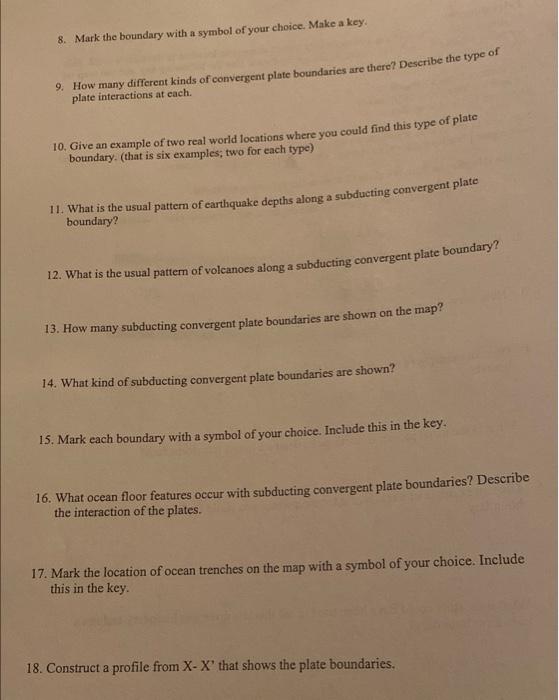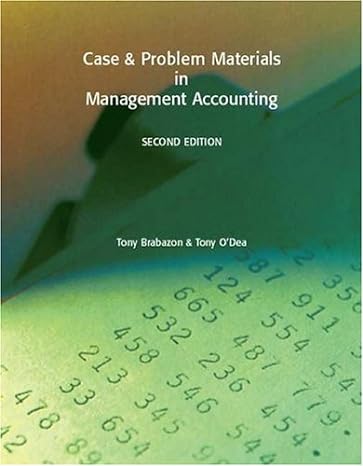I need some help with my lab. Thank you!

Mountain building, volcanism and seismicity occurs at specific location in the earth's crust. This tectonics activity has helps to establish plate boundaries. Use the following key and the map on the next page to interpret the position of plate in an idealized occan. S shallow focus earthquakes I - intermediate focus earthquakes D-deep focus earthquakes Numbers in the circles represent an age in millions of years before present. Only divergent and convergent plate boundaries are shown. The hapes represent volcanoes. Use the information from the class to answer the following questions. 1. What is the usual pattern of earthquake depths along divergent plate boundaries? shallow 2. What is the usual pattern of volcanoes along divergent plate boundaries? deep 3. How many divergent plate boundaries are shown on map? 4. Give an example of two real world locations where you could find this type of plate boundary 5. What is the usual pattern of earthquake depths a long a transform fault? 6. Give an example of a real world location where you could find this type of plate boundary. 7. What indicators could have been used to tell this is a divergent boundary and not a transform boundary? 8. Mark the boundary with a symbol of your choice. Make a key. 9. How many different kinds of convergent plate boundaries are there? Describe the type of plate interactions at each. 10. Give an example of two real world locations where you could find this type of plate boundary. (that is six examples; two for each type) 11. What is the usual pattern of earthquake depths along a subducting convergent plate boundary? 12. What is the usual pattern of volcanoes along a subducting convergent plate boundary? 13. How many subducting convergent plate boundaries are shown on the map? 14. What kind of subducting convergent plate boundaries are shown? 15. Mark each boundary with a symbol of your choice. Include this in the key. 16. What ocean floor features occur with subducting convergent plate boundaries? Describe the interaction of the plates. 17. Mark the location of ocean trenches on the map with a symbol of your choice. Include this in the key 18. Construct a profile from X-X' that shows the plate boundaries. D S s S GE S S S S s D S s S en $ s 1 S S S S co on 20 e S S 09 A SS S s un S s S 45 on S S S s S S s ca S 20 00 SSS S S S S S on S 20 D S S S S S S SS S SS S S S S D D 09 $ S 09 S S D S S S SSS -- D S on D S s S S S D S S S D 1 1 D 1 1 D X Triangles represent volcanoes, black lines are shorelines, numbers represent millions of years and the letter are foci depths of Shallow, Intermediate and Deep. Mountain building, volcanism and seismicity occurs at specific location in the earth's crust. This tectonics activity has helps to establish plate boundaries. Use the following key and the map on the next page to interpret the position of plate in an idealized occan. S shallow focus earthquakes I - intermediate focus earthquakes D-deep focus earthquakes Numbers in the circles represent an age in millions of years before present. Only divergent and convergent plate boundaries are shown. The hapes represent volcanoes. Use the information from the class to answer the following questions. 1. What is the usual pattern of earthquake depths along divergent plate boundaries? shallow 2. What is the usual pattern of volcanoes along divergent plate boundaries? deep 3. How many divergent plate boundaries are shown on map? 4. Give an example of two real world locations where you could find this type of plate boundary 5. What is the usual pattern of earthquake depths a long a transform fault? 6. Give an example of a real world location where you could find this type of plate boundary. 7. What indicators could have been used to tell this is a divergent boundary and not a transform boundary? 8. Mark the boundary with a symbol of your choice. Make a key. 9. How many different kinds of convergent plate boundaries are there? Describe the type of plate interactions at each. 10. Give an example of two real world locations where you could find this type of plate boundary. (that is six examples; two for each type) 11. What is the usual pattern of earthquake depths along a subducting convergent plate boundary? 12. What is the usual pattern of volcanoes along a subducting convergent plate boundary? 13. How many subducting convergent plate boundaries are shown on the map? 14. What kind of subducting convergent plate boundaries are shown? 15. Mark each boundary with a symbol of your choice. Include this in the key. 16. What ocean floor features occur with subducting convergent plate boundaries? Describe the interaction of the plates. 17. Mark the location of ocean trenches on the map with a symbol of your choice. Include this in the key 18. Construct a profile from X-X' that shows the plate boundaries. D S s S GE S S S S s D S s S en $ s 1 S S S S co on 20 e S S 09 A SS S s un S s S 45 on S S S s S S s ca S 20 00 SSS S S S S S on S 20 D S S S S S S SS S SS S S S S D D 09 $ S 09 S S D S S S SSS -- D S on D S s S S S D S S S D 1 1 D 1 1 D X Triangles represent volcanoes, black lines are shorelines, numbers represent millions of years and the letter are foci depths of Shallow, Intermediate and Deep










